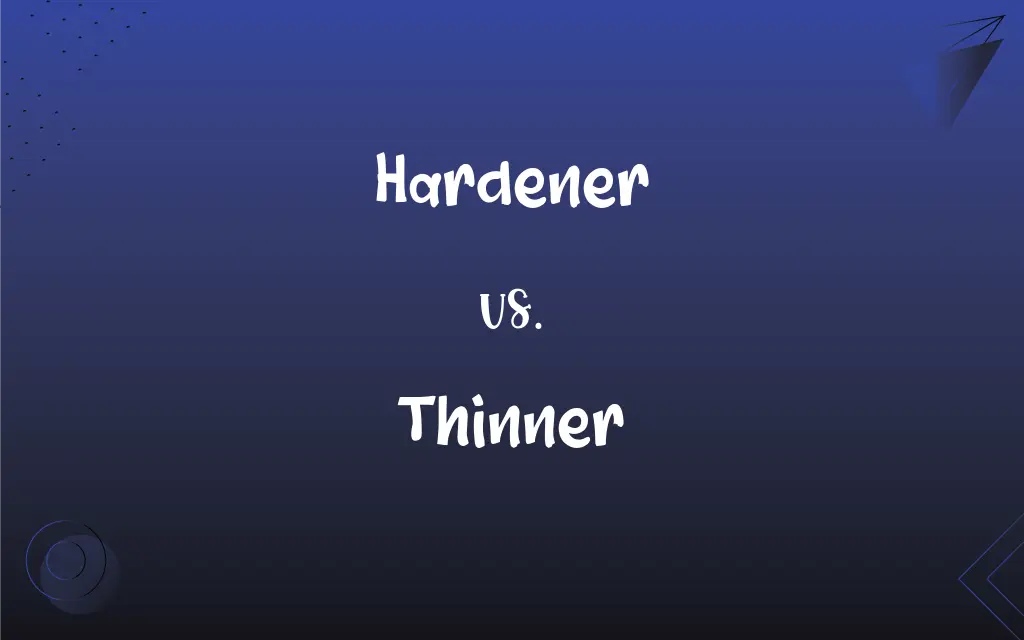Hardener vs. Thinner: What's the Difference?
By Janet White || Published on July 21, 2024
A hardener is a chemical additive used to catalyze or accelerate the curing process of resins or paints, enhancing durability. A thinner, on the other hand, is used to reduce the viscosity of paint or varnish, making it easier to apply or clean up.

Key Differences
Hardeners play a crucial role in the chemical reaction that solidifies resins, paints, or adhesives, often acting as a catalyst to ensure the mixture sets properly. They are essential for applications requiring a strong, durable finish, such as in automotive paints or epoxy resins. Thinners, in contrast, are solvents added to paints or varnishes to dilute them, improving workability and spreading capability. They are chosen based on the type of paint or varnish to avoid affecting the final properties adversely.
The function of a hardener is to interact chemically with the base material, leading to a hardened, cured product with enhanced physical properties. This process is irreversible, meaning once the hardener is added and the product cures, it cannot return to its original liquid state. Thinners, however, temporarily modify the paint's or varnish's viscosity for easier application; as the thinner evaporates, the paint returns to its original state of thickness but remains where it was applied.
Hardeners are specific to the chemistry of the material they are designed to cure, requiring precise mixing ratios for optimal performance. Incorrect proportions can lead to incomplete curing or compromised material strength. Thinners must also be compatible with the paint or varnish they are diluting to prevent unwanted chemical reactions or finish imperfections.
In terms of safety and environmental impact, both hardeners and thinners require careful handling. Hardeners, being reactive, can be hazardous if not used according to safety guidelines. Thinners, being volatile organic compounds (VOCs), pose risks of inhalation hazards and environmental pollution, necessitating proper ventilation and disposal practices.
Understanding the distinct roles of hardeners and thinners is essential for achieving desired results in painting, coating, and adhesive applications. While hardeners ensure the durability and stability of the finish, thinners facilitate the application process, highlighting the balance between chemical reactivity and physical manipulation in material applications.
ADVERTISEMENT
Comparison Chart
Purpose
Accelerates curing process
Reduces viscosity
Function
Catalyzes chemical reaction for curing
Dilutes paint or varnish for better application
Effect on Material
Makes it harder and more durable
Makes it easier to apply and clean
Reversibility
Irreversible
Evaporates, leaving paint or varnish unchanged
Safety Concerns
Reactive and requires careful handling
Flammable, emits VOCs, requires ventilation
ADVERTISEMENT
Hardener and Thinner Definitions
Hardener
Integral to achieving specific material properties.
Use of a hardener in varnish achieves a tough, protective surface.
Thinner
Selected based on compatibility with the paint type.
Water-based thinners are used for acrylic paints.
Hardener
A chemical that catalyzes curing in resins or paints.
Adding a hardener to epoxy resin initiates a reaction that solidifies the mixture.
Thinner
Improves paint or varnish workability.
Adding thinner to varnish makes it easier to apply a uniform coat.
Hardener
Enhances durability of the finished product.
Hardeners in automotive paints ensure a durable, high-gloss finish.
Thinner
Evaporates after application, leaving the paint intact.
The thinner evaporates, allowing the paint to dry correctly.
Hardener
Requires precise mixing ratios.
An incorrect ratio of hardener may lead to a tacky or weak composite material.
Thinner
Used for cleaning painting tools.
Paint thinner cleans brushes and rollers after use.
Hardener
Used in various materials, including plastics and adhesives.
Hardeners in adhesives ensure a strong bond between surfaces.
Thinner
A solvent that reduces the viscosity of paints.
Thinner is added to oil-based paint to facilitate smooth application.
Hardener
One that hardens, especially a substance added to varnish or paint to give it a harder surface or finish.
Thinner
A liquid, such as turpentine, mixed with paint or varnish to reduce its viscosity and make it easier to apply.
Hardener
One who, or that which, hardens.
The hardener of hearts
Hardener
A chemical substance added to something in order to harden it; used especially with paints, varnishes and resins.
Hardener
One who, or that which, hardens; specif., one who tempers tools.
FAQs
Can I use any thinner with any type of paint?
No, thinners must be compatible with the paint type (e.g., water-based, oil-based) to avoid damaging the paint's properties.
How do I determine the correct amount of hardener to use?
The correct amount of hardener is usually specified by the product manufacturer, requiring precise measurement for optimal results.
What is a hardener?
A hardener is a chemical additive used in resins, paints, and adhesives to initiate or accelerate the curing process, resulting in a harder, more durable finish.
What are the environmental concerns associated with using thinners and hardeners?
Both thinners and hardeners can have significant environmental impacts due to their chemical composition. Thinners often contain volatile organic compounds (VOCs) that contribute to air pollution and potential health risks. Hardeners, depending on their chemical nature, can be toxic and pose hazards to water sources and soil if not disposed of properly.
Can hardeners be used with any resin or paint?
Hardeners are formulated to work with specific types of resins or paints, based on the chemistry of the curing process. It's important to use the hardener recommended by the manufacturer to ensure proper curing and performance of the final product.
Is it possible to adjust the drying time of paint by altering the amount of thinner?
Yes, adjusting the amount of thinner can influence the drying time of paint. Adding more thinner can extend the drying time by reducing the paint's viscosity, allowing it to spread more thinly and take longer to evaporate. However, it's important to follow the manufacturer's recommendations to avoid negatively affecting the paint's properties and finish.
Can thinners affect the color or finish of paint?
While thinners primarily affect viscosity, excessive use can potentially affect the opacity and drying time of the paint, possibly impacting the final appearance.
How should I dispose of excess hardener and thinner?
Excess hardener and thinner should be disposed of according to local regulations, as they can be hazardous to the environment and human health.
What is a thinner?
A thinner is a solvent used to reduce the viscosity of paint or varnish, improving its application or clean-up process.
Is it safe to mix hardener and thinner together?
Mixing hardener and thinner together is not typically recommended unless specified by the product's instructions, as they serve different purposes and may not be chemically compatible.
What safety precautions should be taken when using hardeners and thinners?
When using hardeners and thinners, it's crucial to work in a well-ventilated area to avoid inhaling fumes. Protective gloves, goggles, and masks should be worn to prevent skin and eye contact and inhalation of harmful chemicals. Additionally, ensure proper storage and disposal of these substances to prevent accidents and environmental harm.
Are there eco-friendly alternatives to traditional thinners and hardeners?
Yes, there are eco-friendly alternatives available for both thinners and hardeners. These products are formulated to minimize environmental impact and health risks, often using less toxic or natural ingredients. However, their compatibility and effectiveness should be evaluated based on the specific application.
Can I store mixed paint with hardener or paint diluted with thinner for future use?
Once paint is mixed with a hardener, it typically cannot be stored for future use due to the curing process that hardens the paint. Paint diluted with thinner can sometimes be stored if properly sealed, but it's best to mix or dilute only the amount needed for immediate use to ensure the best quality and performance.
How do professionals dispose of leftover hardeners and thinners?
Professionals must follow local regulations and guidelines for hazardous waste disposal when disposing of leftover hardeners and thinners. This often involves taking the materials to a designated hazardous waste facility or participating in community hazardous waste collection events to ensure safe and environmentally responsible disposal.
How do I correct mistakes if too much hardener or thinner has been added?
If too much hardener is added, it may not be possible to correct the mixture, and starting over with a new batch might be necessary. If too much thinner is added, you may be able to compensate by adding more paint or waiting for some of the thinner to evaporate before application. Always consult the product's instructions for guidance on adjustments.
How do temperature and humidity affect the use of hardeners and thinners?
Temperature and humidity can significantly affect the performance of both hardeners and thinners. High temperatures can accelerate the curing process when using hardeners, potentially leading to premature hardening. Humidity can affect the evaporation rate of thinners, impacting the drying time of paint and the overall finish. Manufacturers often provide guidelines for optimal conditions.
Can the use of thinners compromise the strength of a bonded joint or coating?
If used correctly and in the recommended proportions, thinners should not compromise the strength of a bonded joint or coating. However, excessive use of thinner can dilute the paint or adhesive too much, potentially weakening the bond or the coating's durability.
About Author
Written by
Janet WhiteJanet White has been an esteemed writer and blogger for Difference Wiki. Holding a Master's degree in Science and Medical Journalism from the prestigious Boston University, she has consistently demonstrated her expertise and passion for her field. When she's not immersed in her work, Janet relishes her time exercising, delving into a good book, and cherishing moments with friends and family.








































































